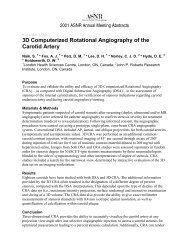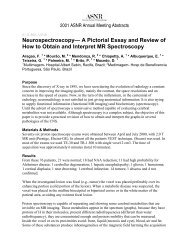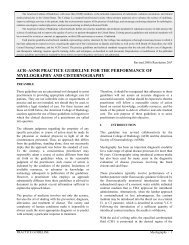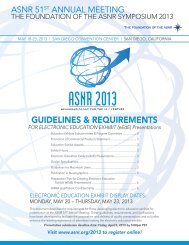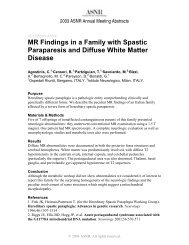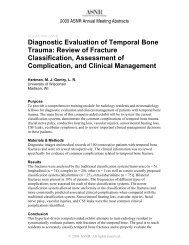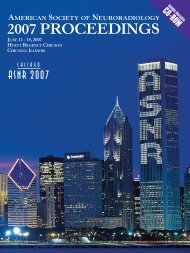acr–asnr–assr–sir–snis practice guideline for the performance of ...
acr–asnr–assr–sir–snis practice guideline for the performance of ...
acr–asnr–assr–sir–snis practice guideline for the performance of ...
- No tags were found...
Create successful ePaper yourself
Turn your PDF publications into a flip-book with our unique Google optimized e-Paper software.
adiologic personnel, and radiationmonitoring requirements.e. Anatomy, physiology, and pathophysiology<strong>of</strong> <strong>the</strong> spine, spinal cord, and nerve roots.f. Pharmacology <strong>of</strong> contrast agents andimplanted materials and recognition andtreatment <strong>of</strong> potential adverse reactions to<strong>the</strong>se substances.g. Technical aspects <strong>of</strong> per<strong>for</strong>ming thisprocedure.The written substantiation should come from <strong>the</strong>chief <strong>of</strong> interventional radiology, <strong>the</strong> chief <strong>of</strong>neuroradiology, <strong>the</strong> chief <strong>of</strong> interventionalneuroradiology, or <strong>the</strong> chair <strong>of</strong> <strong>the</strong> department <strong>of</strong><strong>the</strong> institution in which <strong>the</strong> physician will beproviding <strong>the</strong>se services 1 . Substantiation couldalso come from a prior institution in which <strong>the</strong>physician provided <strong>the</strong> services, but only at <strong>the</strong>discretion <strong>of</strong> <strong>the</strong> current interventional,Neurointerventional, or neuroradiology chief, or<strong>the</strong> chair who solicits <strong>the</strong> additional input.and5. Physicians must possess certain fundamentalknowledge and skills that are required <strong>for</strong> <strong>the</strong>appropriate application and safe per<strong>for</strong>mance <strong>of</strong>vertebral augmentation:a. In addition to a basic understanding <strong>of</strong>spinal anatomy, physiology, andpathophysiology, <strong>the</strong> physician must havesufficient knowledge <strong>of</strong> <strong>the</strong> clinical andimaging evaluation <strong>of</strong> patients with spinaldisorders to determine those <strong>for</strong> whomvertebral augmentation is indicated.b. The physician must fully appreciate <strong>the</strong>benefits and risks <strong>of</strong> vertebral augmentationand <strong>the</strong> alternatives to <strong>the</strong> procedure.c. The physician is required to be competent in<strong>the</strong> use <strong>of</strong> fluoroscopy, CT, and MRI orinterpretation <strong>of</strong> images in <strong>the</strong> modalitiesused to evaluate potential patients and guide<strong>the</strong> vertebral augmentation procedure.d. The physician should be able to recognize,interpret, and act immediately on imagefindings.e. The physician must have <strong>the</strong> ability, skills,and knowledge to evaluate <strong>the</strong> patient’sclinical status and to identify those patientswho might be at increased risk, who mayrequire additional perioperative care, or whohave relative contraindications to <strong>the</strong>procedure.1 At institutions in which <strong>the</strong>re is joint (dual) credentialingacross departments doing like procedures, this substantiation <strong>of</strong>experience should be done by <strong>the</strong> chairs <strong>of</strong> both departments toensure equity <strong>of</strong> experience among practitioners when <strong>the</strong>irtraining backgrounds differ [43].f. The physician must be capable <strong>of</strong> providing<strong>the</strong> initial clinical management <strong>of</strong>complications <strong>of</strong> vertebral augmentation,including administration <strong>of</strong> basic lifesupport, treatment <strong>of</strong> pneumothorax, andrecognition <strong>of</strong> spinal cord compression.g. Training in radiation physics and safety is animportant component <strong>of</strong> <strong>the</strong>se requirements.Such training is important to maximize bothpatient and physician safety. It is highlyrecommended that <strong>the</strong> physician haveadequate training in and be familiar with <strong>the</strong>principles <strong>of</strong> radiation exposure, <strong>the</strong> hazards<strong>of</strong> radiation exposure to both patients andradiologic personnel, and <strong>the</strong> radiationmonitoring requirements <strong>for</strong> <strong>the</strong> imagingmethods listed above.Some methods <strong>of</strong> vertebral augmentation may requirespecialized training and experience, and such needsshould be assessed be<strong>for</strong>e a physician contemplates usingany method.Maintenance <strong>of</strong> CompetencePhysicians should per<strong>for</strong>m a sufficient number <strong>of</strong>vertebral augmentation procedures to maintain <strong>the</strong>ir skills,with acceptable success and complication rates as laid outin this <strong>guideline</strong>. Continued competence depends onparticipation in a quality improvement program thatmonitors <strong>the</strong>se rates. Regular attendance at postgraduatecourses that provide continuing education on diagnosticand technical advances in vertebral augmentation isnecessary.Continuing Medical EducationThe physician’s continuing education should be inaccordance with <strong>the</strong> ACR Practice Guideline <strong>for</strong>Continuing Medical Education (CME).B. Nonphysician PractitionersPhysician assistants and nurse practitioners can bevaluable members <strong>of</strong> <strong>the</strong> interventional radiology teambut not as primary operator. These nonphysicianpractitioners can function as independent members <strong>of</strong> <strong>the</strong>team but not as primary operator. See <strong>the</strong> ACR–SIR–SNIS Practice Guideline <strong>for</strong> Interventional ClinicalPractice.C. Qualified Medical PhysicistA Qualified Medical Physicist is an individual who iscompetent to <strong>practice</strong> independently one or more <strong>of</strong> <strong>the</strong>subfields in medical physics. The American College <strong>of</strong>Radiology (ACR) considers certification, continuingeducation, and experience in <strong>the</strong> appropriate subfield(s) to4 / Vertebral Augmentation PRACTICE GUIDELINE



